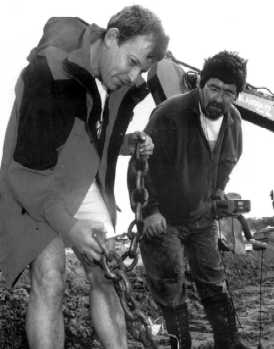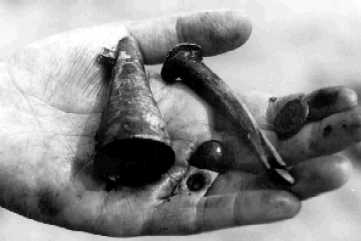|
|
|
The wreck of HMS Havick 1800
Uncovering the wreck
So how was the wreck found?
The wreck site was discovered by Henry Connolly, a member of the Jersey Detecting Club in 1987. Together with other members of the group they kept the site a secret for fear of it being spoilt by treasure seekers. In early 1997 they approached the Jersey Museum and have worked closely together on the project ever since.
Excavating the wreck

Before any excavations could begin the site had to be properly mapped to give the archaeologists an idea of where they were likely to find articles. Due to the fact that the site is between tides the aim was to work the site for a few hours a day. Using a mechanised digger for speed the top sand was removed to a depth of about four feet and then each article was carefully removed using smaller specialised tools. Each article was then given a catalogue number, bagged and recorded. The work was carried out over two days for roughly four hours per day. In 1998 another four days excavations produced more artefacts and, in late spring this year, it is hoped that another excavation can take place.
Peter Bohea and Henry Connell lifting copper chain from the excavation site
Fresh from nearly two centuries beneath the sand - a candle snuffer, rivet, buttons and a musket ball.

Preservation and Conservation.
In order to preserve many of the articles recovered, they needed to be treated quickly. Most of the articles were transferred into two large tanks and covered in water to prevent them from drying out and cracking. The salt needs to be leached out otherwise it could cause serious damage and ruin the articles. Most of the iron that was recovered needed to be put in a special weak acid based solution in order to stop it from disintegrating and cracking. Once the articles had been left for a matter of weeks the next step was to go through the catalogue taken on site and clean and check each article against its catalogue number. These were recorded and kept. The final step was to select the items that would form part of the display at the Maritime Museum. We have tried to present a broad cross section of the articles recovered and show how they have been affected by nearly two hundred years buried under water.
Detective work - how did we identify the wreck as being HMS Havick?
We were able to identify the wreck with a degree of certainty because of various clues contained in the artefacts recovered – much of directly associated with the Royal Navy. The buttons that were found simply showed the fouled anchor – the crown on the Royal Navy symbol was only added after 1812 so we were looking for a vessel before that date. However, because the bottom of the ship was coppered it was possible to look for a shipwreck after the American Wars of Independence (1776-83) when British ships began to use it,.
Much of the copper sheeting that was recovered was marked with the dated 1795-1797, also everything from the copper plating to the individual nails were stamped with the Government property arrow. This enabled us to identify it as a Royal Naval ship that was either built or refitted after 1797. Fortunately the Royal Navy kept very comprehensive records and were able to give details of the ships that had been wrecked around this time in St Aubin's Bay. Also local records showed that there had been a tremendous storm in 1800 in which at least three ships had been wrecked. After contacting the Royal Naval Museum and the Admiralty Library we obtained a cutting from The Times dated 14 November 1800 which reported the sinking of His Majesty's sloops Pelican and Havick in St Aubin's Bay. This narrowed the search down to two possible ships. The puzzle was then solved by the discovery with the help of the Naval Historical Library that HMS Pelican was subsequently recovered and towed alongside the pier at St Helier. This meant that the identity of the ship in question was, beyond any reasonable doubt, HMS Havick. A report from Portsmouth dated 12 November mentions HMS Lion,14 guns. Lieutenant Tathum and a Guernsey privateer also being driven from their anchors and bilged.

HMS Havick 1797-1800
Click here to continue to
The Last hours on board HMS HavickClick here to return to
The wreck of HMS Havick 1800Click here to return to
Patrimoine